Global and Transnational Business
VerifiedAdded on 2023/01/10
|11
|4387
|73
AI Summary
This report discusses the external environment analysis of IKEA, issues related to cross cultures and key cultural risks with IKEA moving to India, and ethical considerations related to expanding into the Indian market. It also explores the advantages and disadvantages of investing in emerging economies and India.
Contribute Materials
Your contribution can guide someone’s learning journey. Share your
documents today.
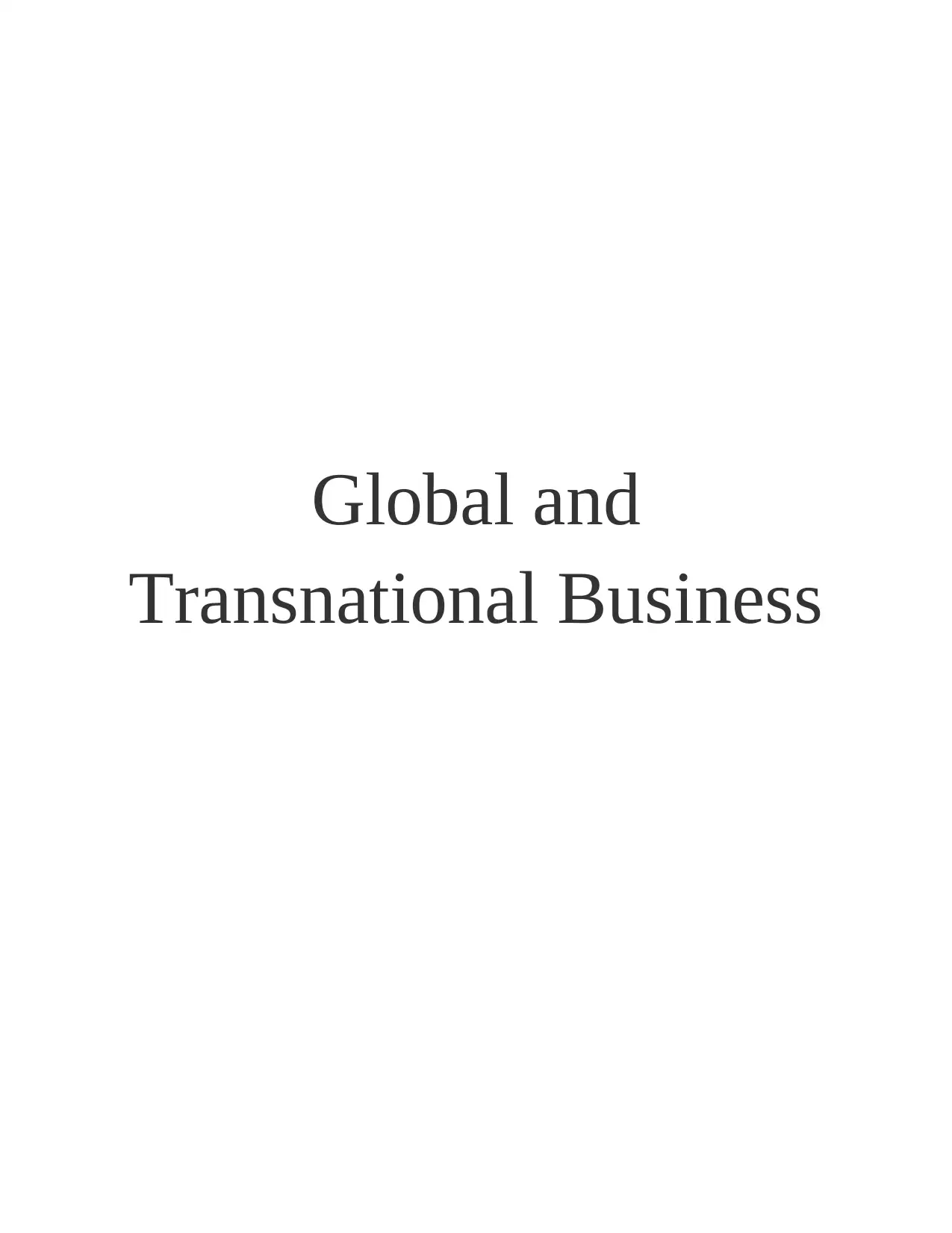
Global and
Transnational Business
Transnational Business
Secure Best Marks with AI Grader
Need help grading? Try our AI Grader for instant feedback on your assignments.

Contents
INTRODUCTION...........................................................................................................................3
TASK 1............................................................................................................................................3
External environment analysis.....................................................................................................3
Issues related to cross cultures and the key cultural risks with IKEA moving to India...............4
Ethical considerations related to expanding into the Indian market............................................6
Advantages and disadvantages of investing in emerging economies and India. Also the
discussion of advantages and disadvantages which the company obtained in India...................8
CONCLUSION................................................................................................................................9
REFERNCES.................................................................................................................................10
INTRODUCTION...........................................................................................................................3
TASK 1............................................................................................................................................3
External environment analysis.....................................................................................................3
Issues related to cross cultures and the key cultural risks with IKEA moving to India...............4
Ethical considerations related to expanding into the Indian market............................................6
Advantages and disadvantages of investing in emerging economies and India. Also the
discussion of advantages and disadvantages which the company obtained in India...................8
CONCLUSION................................................................................................................................9
REFERNCES.................................................................................................................................10
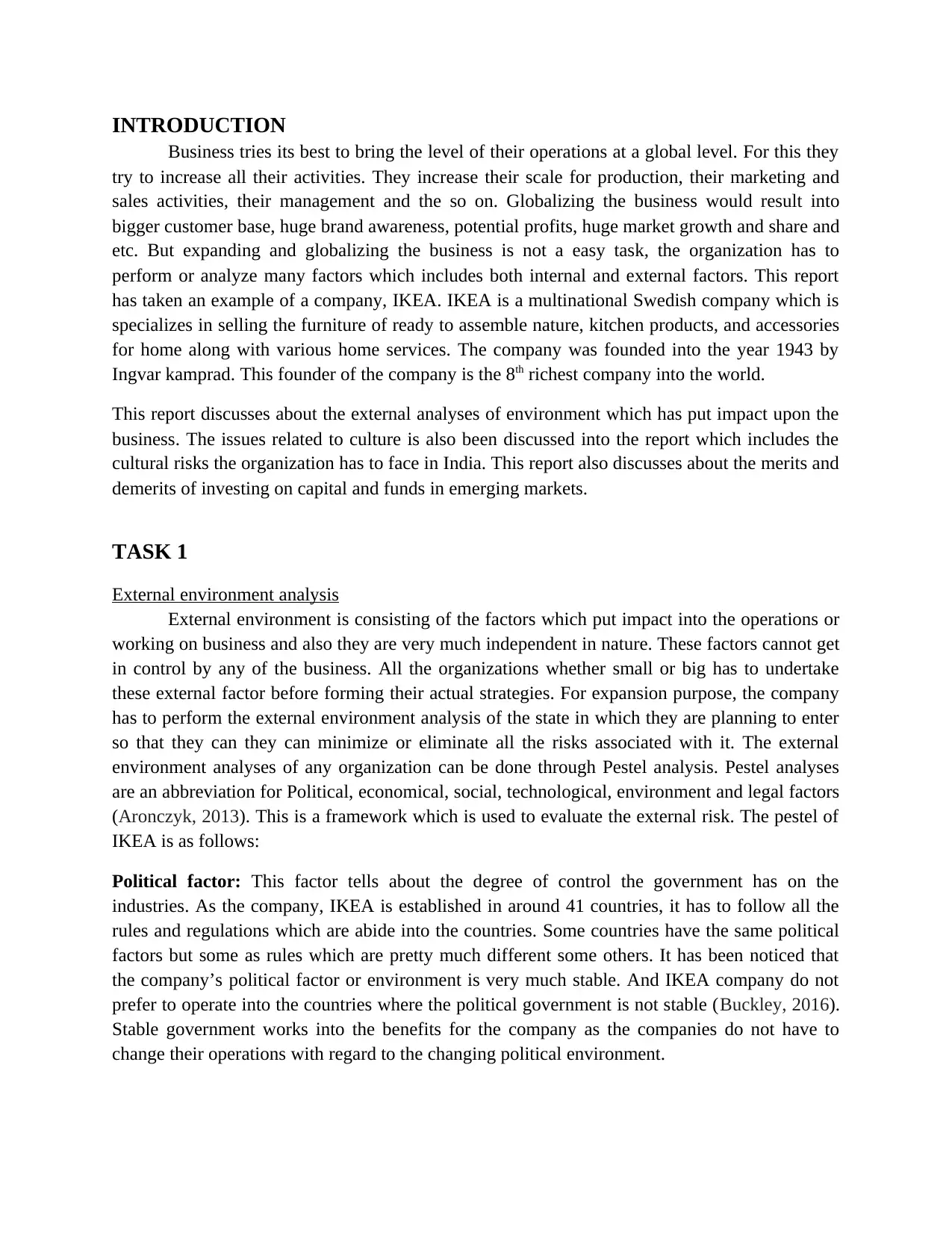
INTRODUCTION
Business tries its best to bring the level of their operations at a global level. For this they
try to increase all their activities. They increase their scale for production, their marketing and
sales activities, their management and the so on. Globalizing the business would result into
bigger customer base, huge brand awareness, potential profits, huge market growth and share and
etc. But expanding and globalizing the business is not a easy task, the organization has to
perform or analyze many factors which includes both internal and external factors. This report
has taken an example of a company, IKEA. IKEA is a multinational Swedish company which is
specializes in selling the furniture of ready to assemble nature, kitchen products, and accessories
for home along with various home services. The company was founded into the year 1943 by
Ingvar kamprad. This founder of the company is the 8th richest company into the world.
This report discusses about the external analyses of environment which has put impact upon the
business. The issues related to culture is also been discussed into the report which includes the
cultural risks the organization has to face in India. This report also discusses about the merits and
demerits of investing on capital and funds in emerging markets.
TASK 1
External environment analysis
External environment is consisting of the factors which put impact into the operations or
working on business and also they are very much independent in nature. These factors cannot get
in control by any of the business. All the organizations whether small or big has to undertake
these external factor before forming their actual strategies. For expansion purpose, the company
has to perform the external environment analysis of the state in which they are planning to enter
so that they can they can minimize or eliminate all the risks associated with it. The external
environment analyses of any organization can be done through Pestel analysis. Pestel analyses
are an abbreviation for Political, economical, social, technological, environment and legal factors
(Aronczyk, 2013). This is a framework which is used to evaluate the external risk. The pestel of
IKEA is as follows:
Political factor: This factor tells about the degree of control the government has on the
industries. As the company, IKEA is established in around 41 countries, it has to follow all the
rules and regulations which are abide into the countries. Some countries have the same political
factors but some as rules which are pretty much different some others. It has been noticed that
the company’s political factor or environment is very much stable. And IKEA company do not
prefer to operate into the countries where the political government is not stable (Buckley, 2016).
Stable government works into the benefits for the company as the companies do not have to
change their operations with regard to the changing political environment.
Business tries its best to bring the level of their operations at a global level. For this they
try to increase all their activities. They increase their scale for production, their marketing and
sales activities, their management and the so on. Globalizing the business would result into
bigger customer base, huge brand awareness, potential profits, huge market growth and share and
etc. But expanding and globalizing the business is not a easy task, the organization has to
perform or analyze many factors which includes both internal and external factors. This report
has taken an example of a company, IKEA. IKEA is a multinational Swedish company which is
specializes in selling the furniture of ready to assemble nature, kitchen products, and accessories
for home along with various home services. The company was founded into the year 1943 by
Ingvar kamprad. This founder of the company is the 8th richest company into the world.
This report discusses about the external analyses of environment which has put impact upon the
business. The issues related to culture is also been discussed into the report which includes the
cultural risks the organization has to face in India. This report also discusses about the merits and
demerits of investing on capital and funds in emerging markets.
TASK 1
External environment analysis
External environment is consisting of the factors which put impact into the operations or
working on business and also they are very much independent in nature. These factors cannot get
in control by any of the business. All the organizations whether small or big has to undertake
these external factor before forming their actual strategies. For expansion purpose, the company
has to perform the external environment analysis of the state in which they are planning to enter
so that they can they can minimize or eliminate all the risks associated with it. The external
environment analyses of any organization can be done through Pestel analysis. Pestel analyses
are an abbreviation for Political, economical, social, technological, environment and legal factors
(Aronczyk, 2013). This is a framework which is used to evaluate the external risk. The pestel of
IKEA is as follows:
Political factor: This factor tells about the degree of control the government has on the
industries. As the company, IKEA is established in around 41 countries, it has to follow all the
rules and regulations which are abide into the countries. Some countries have the same political
factors but some as rules which are pretty much different some others. It has been noticed that
the company’s political factor or environment is very much stable. And IKEA company do not
prefer to operate into the countries where the political government is not stable (Buckley, 2016).
Stable government works into the benefits for the company as the companies do not have to
change their operations with regard to the changing political environment.
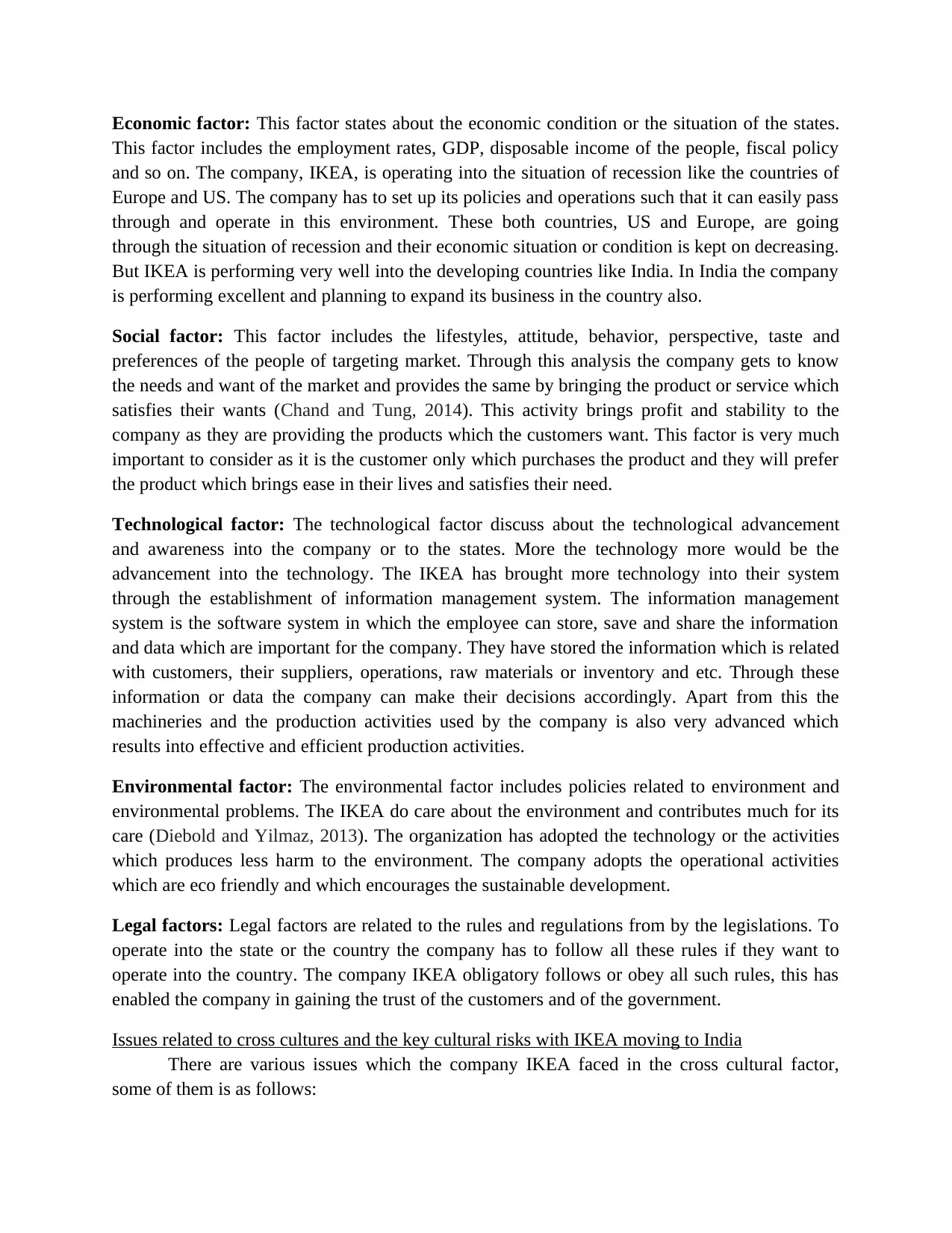
Economic factor: This factor states about the economic condition or the situation of the states.
This factor includes the employment rates, GDP, disposable income of the people, fiscal policy
and so on. The company, IKEA, is operating into the situation of recession like the countries of
Europe and US. The company has to set up its policies and operations such that it can easily pass
through and operate in this environment. These both countries, US and Europe, are going
through the situation of recession and their economic situation or condition is kept on decreasing.
But IKEA is performing very well into the developing countries like India. In India the company
is performing excellent and planning to expand its business in the country also.
Social factor: This factor includes the lifestyles, attitude, behavior, perspective, taste and
preferences of the people of targeting market. Through this analysis the company gets to know
the needs and want of the market and provides the same by bringing the product or service which
satisfies their wants (Chand and Tung, 2014). This activity brings profit and stability to the
company as they are providing the products which the customers want. This factor is very much
important to consider as it is the customer only which purchases the product and they will prefer
the product which brings ease in their lives and satisfies their need.
Technological factor: The technological factor discuss about the technological advancement
and awareness into the company or to the states. More the technology more would be the
advancement into the technology. The IKEA has brought more technology into their system
through the establishment of information management system. The information management
system is the software system in which the employee can store, save and share the information
and data which are important for the company. They have stored the information which is related
with customers, their suppliers, operations, raw materials or inventory and etc. Through these
information or data the company can make their decisions accordingly. Apart from this the
machineries and the production activities used by the company is also very advanced which
results into effective and efficient production activities.
Environmental factor: The environmental factor includes policies related to environment and
environmental problems. The IKEA do care about the environment and contributes much for its
care (Diebold and Yilmaz, 2013). The organization has adopted the technology or the activities
which produces less harm to the environment. The company adopts the operational activities
which are eco friendly and which encourages the sustainable development.
Legal factors: Legal factors are related to the rules and regulations from by the legislations. To
operate into the state or the country the company has to follow all these rules if they want to
operate into the country. The company IKEA obligatory follows or obey all such rules, this has
enabled the company in gaining the trust of the customers and of the government.
Issues related to cross cultures and the key cultural risks with IKEA moving to India
There are various issues which the company IKEA faced in the cross cultural factor,
some of them is as follows:
This factor includes the employment rates, GDP, disposable income of the people, fiscal policy
and so on. The company, IKEA, is operating into the situation of recession like the countries of
Europe and US. The company has to set up its policies and operations such that it can easily pass
through and operate in this environment. These both countries, US and Europe, are going
through the situation of recession and their economic situation or condition is kept on decreasing.
But IKEA is performing very well into the developing countries like India. In India the company
is performing excellent and planning to expand its business in the country also.
Social factor: This factor includes the lifestyles, attitude, behavior, perspective, taste and
preferences of the people of targeting market. Through this analysis the company gets to know
the needs and want of the market and provides the same by bringing the product or service which
satisfies their wants (Chand and Tung, 2014). This activity brings profit and stability to the
company as they are providing the products which the customers want. This factor is very much
important to consider as it is the customer only which purchases the product and they will prefer
the product which brings ease in their lives and satisfies their need.
Technological factor: The technological factor discuss about the technological advancement
and awareness into the company or to the states. More the technology more would be the
advancement into the technology. The IKEA has brought more technology into their system
through the establishment of information management system. The information management
system is the software system in which the employee can store, save and share the information
and data which are important for the company. They have stored the information which is related
with customers, their suppliers, operations, raw materials or inventory and etc. Through these
information or data the company can make their decisions accordingly. Apart from this the
machineries and the production activities used by the company is also very advanced which
results into effective and efficient production activities.
Environmental factor: The environmental factor includes policies related to environment and
environmental problems. The IKEA do care about the environment and contributes much for its
care (Diebold and Yilmaz, 2013). The organization has adopted the technology or the activities
which produces less harm to the environment. The company adopts the operational activities
which are eco friendly and which encourages the sustainable development.
Legal factors: Legal factors are related to the rules and regulations from by the legislations. To
operate into the state or the country the company has to follow all these rules if they want to
operate into the country. The company IKEA obligatory follows or obey all such rules, this has
enabled the company in gaining the trust of the customers and of the government.
Issues related to cross cultures and the key cultural risks with IKEA moving to India
There are various issues which the company IKEA faced in the cross cultural factor,
some of them is as follows:
Secure Best Marks with AI Grader
Need help grading? Try our AI Grader for instant feedback on your assignments.
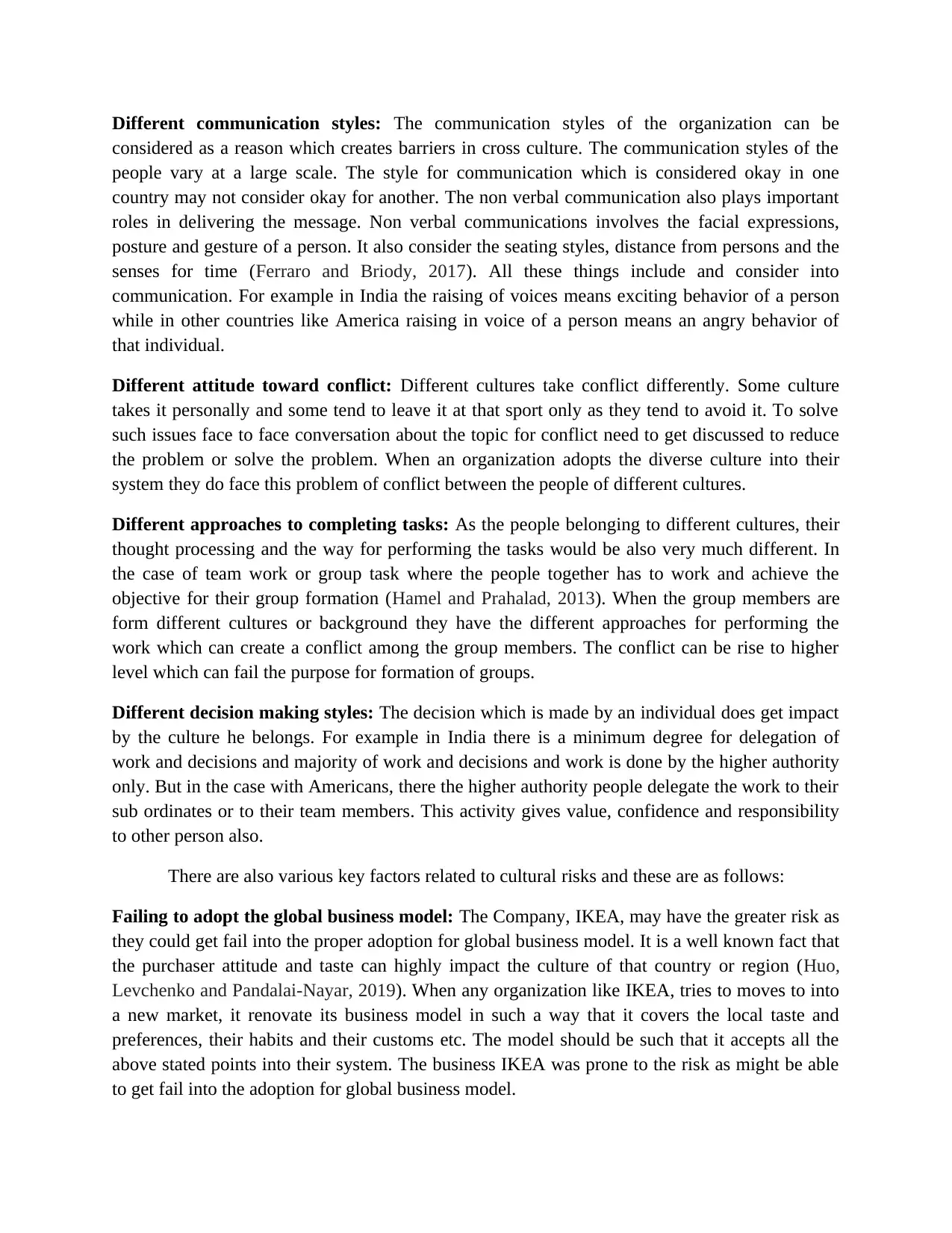
Different communication styles: The communication styles of the organization can be
considered as a reason which creates barriers in cross culture. The communication styles of the
people vary at a large scale. The style for communication which is considered okay in one
country may not consider okay for another. The non verbal communication also plays important
roles in delivering the message. Non verbal communications involves the facial expressions,
posture and gesture of a person. It also consider the seating styles, distance from persons and the
senses for time (Ferraro and Briody, 2017). All these things include and consider into
communication. For example in India the raising of voices means exciting behavior of a person
while in other countries like America raising in voice of a person means an angry behavior of
that individual.
Different attitude toward conflict: Different cultures take conflict differently. Some culture
takes it personally and some tend to leave it at that sport only as they tend to avoid it. To solve
such issues face to face conversation about the topic for conflict need to get discussed to reduce
the problem or solve the problem. When an organization adopts the diverse culture into their
system they do face this problem of conflict between the people of different cultures.
Different approaches to completing tasks: As the people belonging to different cultures, their
thought processing and the way for performing the tasks would be also very much different. In
the case of team work or group task where the people together has to work and achieve the
objective for their group formation (Hamel and Prahalad, 2013). When the group members are
form different cultures or background they have the different approaches for performing the
work which can create a conflict among the group members. The conflict can be rise to higher
level which can fail the purpose for formation of groups.
Different decision making styles: The decision which is made by an individual does get impact
by the culture he belongs. For example in India there is a minimum degree for delegation of
work and decisions and majority of work and decisions and work is done by the higher authority
only. But in the case with Americans, there the higher authority people delegate the work to their
sub ordinates or to their team members. This activity gives value, confidence and responsibility
to other person also.
There are also various key factors related to cultural risks and these are as follows:
Failing to adopt the global business model: The Company, IKEA, may have the greater risk as
they could get fail into the proper adoption for global business model. It is a well known fact that
the purchaser attitude and taste can highly impact the culture of that country or region (Huo,
Levchenko and Pandalai-Nayar, 2019). When any organization like IKEA, tries to moves to into
a new market, it renovate its business model in such a way that it covers the local taste and
preferences, their habits and their customs etc. The model should be such that it accepts all the
above stated points into their system. The business IKEA was prone to the risk as might be able
to get fail into the adoption for global business model.
considered as a reason which creates barriers in cross culture. The communication styles of the
people vary at a large scale. The style for communication which is considered okay in one
country may not consider okay for another. The non verbal communication also plays important
roles in delivering the message. Non verbal communications involves the facial expressions,
posture and gesture of a person. It also consider the seating styles, distance from persons and the
senses for time (Ferraro and Briody, 2017). All these things include and consider into
communication. For example in India the raising of voices means exciting behavior of a person
while in other countries like America raising in voice of a person means an angry behavior of
that individual.
Different attitude toward conflict: Different cultures take conflict differently. Some culture
takes it personally and some tend to leave it at that sport only as they tend to avoid it. To solve
such issues face to face conversation about the topic for conflict need to get discussed to reduce
the problem or solve the problem. When an organization adopts the diverse culture into their
system they do face this problem of conflict between the people of different cultures.
Different approaches to completing tasks: As the people belonging to different cultures, their
thought processing and the way for performing the tasks would be also very much different. In
the case of team work or group task where the people together has to work and achieve the
objective for their group formation (Hamel and Prahalad, 2013). When the group members are
form different cultures or background they have the different approaches for performing the
work which can create a conflict among the group members. The conflict can be rise to higher
level which can fail the purpose for formation of groups.
Different decision making styles: The decision which is made by an individual does get impact
by the culture he belongs. For example in India there is a minimum degree for delegation of
work and decisions and majority of work and decisions and work is done by the higher authority
only. But in the case with Americans, there the higher authority people delegate the work to their
sub ordinates or to their team members. This activity gives value, confidence and responsibility
to other person also.
There are also various key factors related to cultural risks and these are as follows:
Failing to adopt the global business model: The Company, IKEA, may have the greater risk as
they could get fail into the proper adoption for global business model. It is a well known fact that
the purchaser attitude and taste can highly impact the culture of that country or region (Huo,
Levchenko and Pandalai-Nayar, 2019). When any organization like IKEA, tries to moves to into
a new market, it renovate its business model in such a way that it covers the local taste and
preferences, their habits and their customs etc. The model should be such that it accepts all the
above stated points into their system. The business IKEA was prone to the risk as might be able
to get fail into the adoption for global business model.
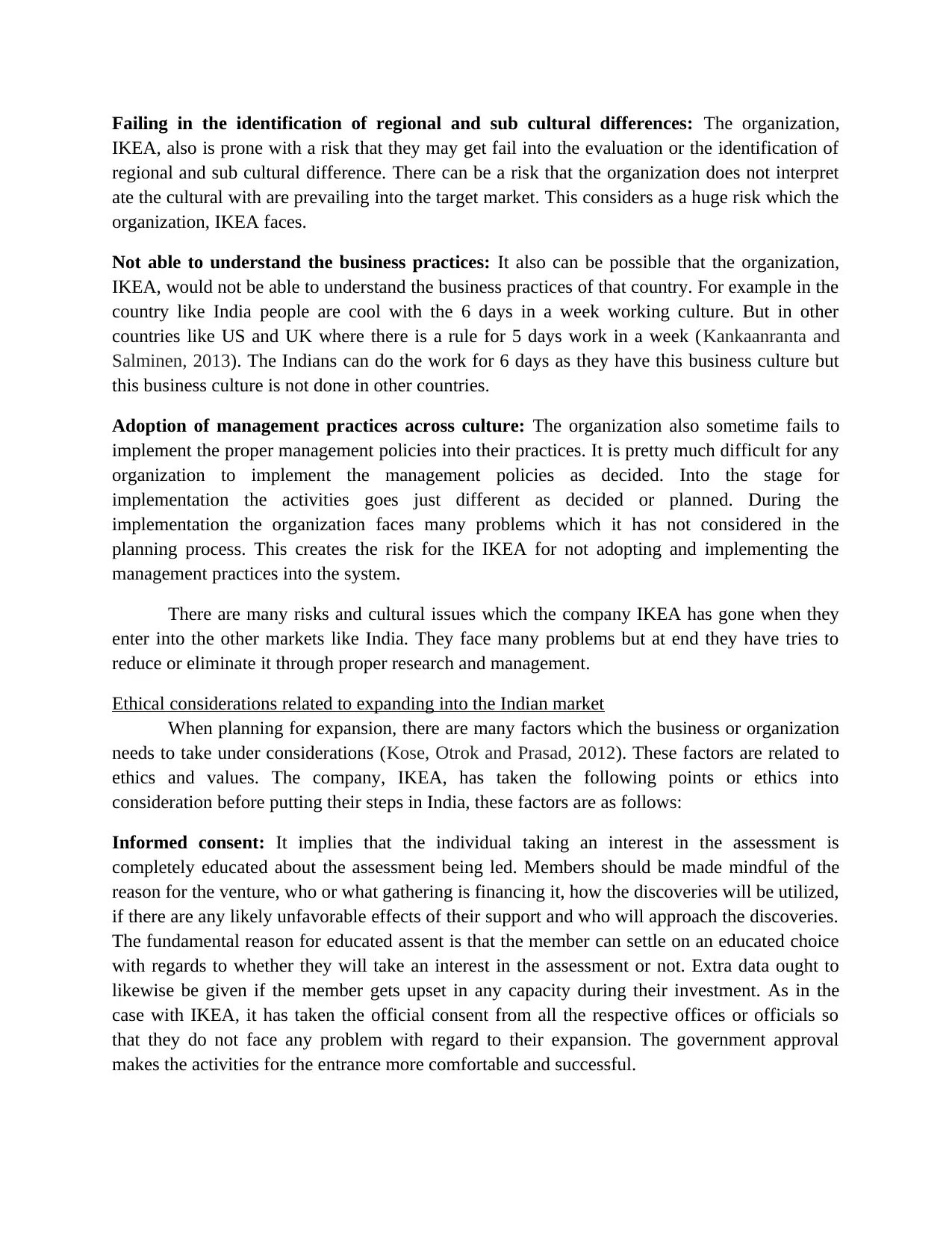
Failing in the identification of regional and sub cultural differences: The organization,
IKEA, also is prone with a risk that they may get fail into the evaluation or the identification of
regional and sub cultural difference. There can be a risk that the organization does not interpret
ate the cultural with are prevailing into the target market. This considers as a huge risk which the
organization, IKEA faces.
Not able to understand the business practices: It also can be possible that the organization,
IKEA, would not be able to understand the business practices of that country. For example in the
country like India people are cool with the 6 days in a week working culture. But in other
countries like US and UK where there is a rule for 5 days work in a week (Kankaanranta and
Salminen, 2013). The Indians can do the work for 6 days as they have this business culture but
this business culture is not done in other countries.
Adoption of management practices across culture: The organization also sometime fails to
implement the proper management policies into their practices. It is pretty much difficult for any
organization to implement the management policies as decided. Into the stage for
implementation the activities goes just different as decided or planned. During the
implementation the organization faces many problems which it has not considered in the
planning process. This creates the risk for the IKEA for not adopting and implementing the
management practices into the system.
There are many risks and cultural issues which the company IKEA has gone when they
enter into the other markets like India. They face many problems but at end they have tries to
reduce or eliminate it through proper research and management.
Ethical considerations related to expanding into the Indian market
When planning for expansion, there are many factors which the business or organization
needs to take under considerations (Kose, Otrok and Prasad, 2012). These factors are related to
ethics and values. The company, IKEA, has taken the following points or ethics into
consideration before putting their steps in India, these factors are as follows:
Informed consent: It implies that the individual taking an interest in the assessment is
completely educated about the assessment being led. Members should be made mindful of the
reason for the venture, who or what gathering is financing it, how the discoveries will be utilized,
if there are any likely unfavorable effects of their support and who will approach the discoveries.
The fundamental reason for educated assent is that the member can settle on an educated choice
with regards to whether they will take an interest in the assessment or not. Extra data ought to
likewise be given if the member gets upset in any capacity during their investment. As in the
case with IKEA, it has taken the official consent from all the respective offices or officials so
that they do not face any problem with regard to their expansion. The government approval
makes the activities for the entrance more comfortable and successful.
IKEA, also is prone with a risk that they may get fail into the evaluation or the identification of
regional and sub cultural difference. There can be a risk that the organization does not interpret
ate the cultural with are prevailing into the target market. This considers as a huge risk which the
organization, IKEA faces.
Not able to understand the business practices: It also can be possible that the organization,
IKEA, would not be able to understand the business practices of that country. For example in the
country like India people are cool with the 6 days in a week working culture. But in other
countries like US and UK where there is a rule for 5 days work in a week (Kankaanranta and
Salminen, 2013). The Indians can do the work for 6 days as they have this business culture but
this business culture is not done in other countries.
Adoption of management practices across culture: The organization also sometime fails to
implement the proper management policies into their practices. It is pretty much difficult for any
organization to implement the management policies as decided. Into the stage for
implementation the activities goes just different as decided or planned. During the
implementation the organization faces many problems which it has not considered in the
planning process. This creates the risk for the IKEA for not adopting and implementing the
management practices into the system.
There are many risks and cultural issues which the company IKEA has gone when they
enter into the other markets like India. They face many problems but at end they have tries to
reduce or eliminate it through proper research and management.
Ethical considerations related to expanding into the Indian market
When planning for expansion, there are many factors which the business or organization
needs to take under considerations (Kose, Otrok and Prasad, 2012). These factors are related to
ethics and values. The company, IKEA, has taken the following points or ethics into
consideration before putting their steps in India, these factors are as follows:
Informed consent: It implies that the individual taking an interest in the assessment is
completely educated about the assessment being led. Members should be made mindful of the
reason for the venture, who or what gathering is financing it, how the discoveries will be utilized,
if there are any likely unfavorable effects of their support and who will approach the discoveries.
The fundamental reason for educated assent is that the member can settle on an educated choice
with regards to whether they will take an interest in the assessment or not. Extra data ought to
likewise be given if the member gets upset in any capacity during their investment. As in the
case with IKEA, it has taken the official consent from all the respective offices or officials so
that they do not face any problem with regard to their expansion. The government approval
makes the activities for the entrance more comfortable and successful.
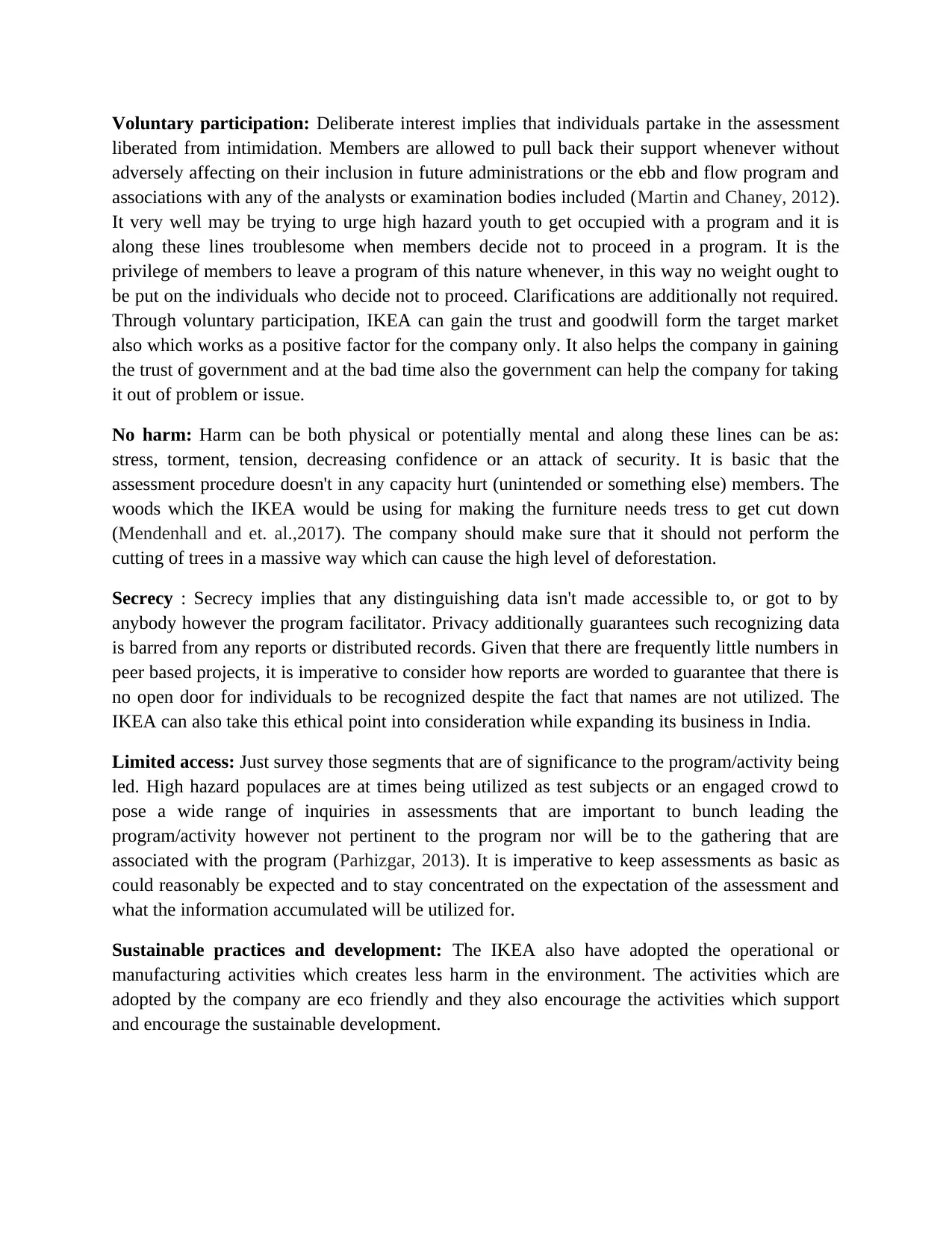
Voluntary participation: Deliberate interest implies that individuals partake in the assessment
liberated from intimidation. Members are allowed to pull back their support whenever without
adversely affecting on their inclusion in future administrations or the ebb and flow program and
associations with any of the analysts or examination bodies included (Martin and Chaney, 2012).
It very well may be trying to urge high hazard youth to get occupied with a program and it is
along these lines troublesome when members decide not to proceed in a program. It is the
privilege of members to leave a program of this nature whenever, in this way no weight ought to
be put on the individuals who decide not to proceed. Clarifications are additionally not required.
Through voluntary participation, IKEA can gain the trust and goodwill form the target market
also which works as a positive factor for the company only. It also helps the company in gaining
the trust of government and at the bad time also the government can help the company for taking
it out of problem or issue.
No harm: Harm can be both physical or potentially mental and along these lines can be as:
stress, torment, tension, decreasing confidence or an attack of security. It is basic that the
assessment procedure doesn't in any capacity hurt (unintended or something else) members. The
woods which the IKEA would be using for making the furniture needs tress to get cut down
(Mendenhall and et. al.,2017). The company should make sure that it should not perform the
cutting of trees in a massive way which can cause the high level of deforestation.
Secrecy : Secrecy implies that any distinguishing data isn't made accessible to, or got to by
anybody however the program facilitator. Privacy additionally guarantees such recognizing data
is barred from any reports or distributed records. Given that there are frequently little numbers in
peer based projects, it is imperative to consider how reports are worded to guarantee that there is
no open door for individuals to be recognized despite the fact that names are not utilized. The
IKEA can also take this ethical point into consideration while expanding its business in India.
Limited access: Just survey those segments that are of significance to the program/activity being
led. High hazard populaces are at times being utilized as test subjects or an engaged crowd to
pose a wide range of inquiries in assessments that are important to bunch leading the
program/activity however not pertinent to the program nor will be to the gathering that are
associated with the program (Parhizgar, 2013). It is imperative to keep assessments as basic as
could reasonably be expected and to stay concentrated on the expectation of the assessment and
what the information accumulated will be utilized for.
Sustainable practices and development: The IKEA also have adopted the operational or
manufacturing activities which creates less harm in the environment. The activities which are
adopted by the company are eco friendly and they also encourage the activities which support
and encourage the sustainable development.
liberated from intimidation. Members are allowed to pull back their support whenever without
adversely affecting on their inclusion in future administrations or the ebb and flow program and
associations with any of the analysts or examination bodies included (Martin and Chaney, 2012).
It very well may be trying to urge high hazard youth to get occupied with a program and it is
along these lines troublesome when members decide not to proceed in a program. It is the
privilege of members to leave a program of this nature whenever, in this way no weight ought to
be put on the individuals who decide not to proceed. Clarifications are additionally not required.
Through voluntary participation, IKEA can gain the trust and goodwill form the target market
also which works as a positive factor for the company only. It also helps the company in gaining
the trust of government and at the bad time also the government can help the company for taking
it out of problem or issue.
No harm: Harm can be both physical or potentially mental and along these lines can be as:
stress, torment, tension, decreasing confidence or an attack of security. It is basic that the
assessment procedure doesn't in any capacity hurt (unintended or something else) members. The
woods which the IKEA would be using for making the furniture needs tress to get cut down
(Mendenhall and et. al.,2017). The company should make sure that it should not perform the
cutting of trees in a massive way which can cause the high level of deforestation.
Secrecy : Secrecy implies that any distinguishing data isn't made accessible to, or got to by
anybody however the program facilitator. Privacy additionally guarantees such recognizing data
is barred from any reports or distributed records. Given that there are frequently little numbers in
peer based projects, it is imperative to consider how reports are worded to guarantee that there is
no open door for individuals to be recognized despite the fact that names are not utilized. The
IKEA can also take this ethical point into consideration while expanding its business in India.
Limited access: Just survey those segments that are of significance to the program/activity being
led. High hazard populaces are at times being utilized as test subjects or an engaged crowd to
pose a wide range of inquiries in assessments that are important to bunch leading the
program/activity however not pertinent to the program nor will be to the gathering that are
associated with the program (Parhizgar, 2013). It is imperative to keep assessments as basic as
could reasonably be expected and to stay concentrated on the expectation of the assessment and
what the information accumulated will be utilized for.
Sustainable practices and development: The IKEA also have adopted the operational or
manufacturing activities which creates less harm in the environment. The activities which are
adopted by the company are eco friendly and they also encourage the activities which support
and encourage the sustainable development.
Paraphrase This Document
Need a fresh take? Get an instant paraphrase of this document with our AI Paraphraser
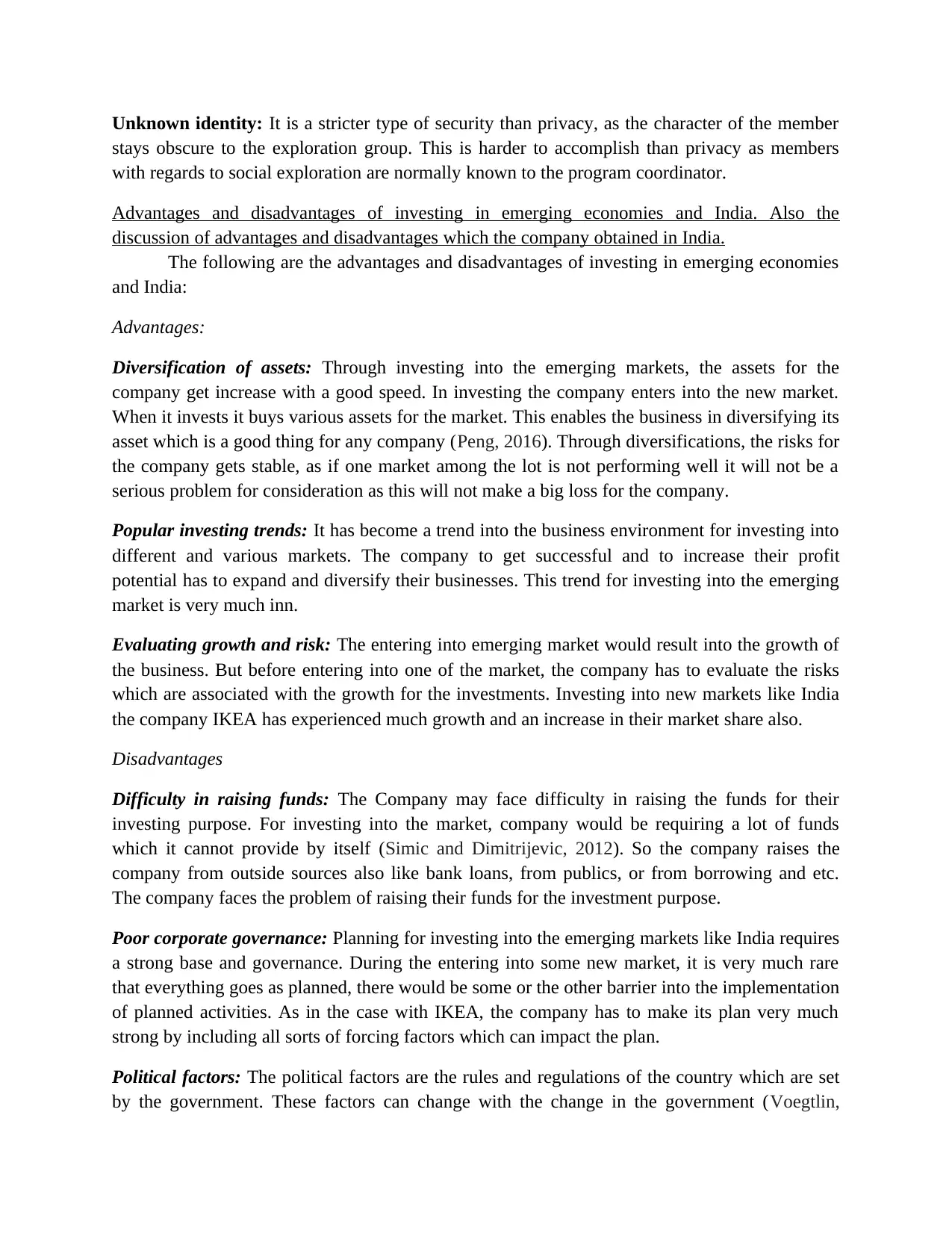
Unknown identity: It is a stricter type of security than privacy, as the character of the member
stays obscure to the exploration group. This is harder to accomplish than privacy as members
with regards to social exploration are normally known to the program coordinator.
Advantages and disadvantages of investing in emerging economies and India. Also the
discussion of advantages and disadvantages which the company obtained in India.
The following are the advantages and disadvantages of investing in emerging economies
and India:
Advantages:
Diversification of assets: Through investing into the emerging markets, the assets for the
company get increase with a good speed. In investing the company enters into the new market.
When it invests it buys various assets for the market. This enables the business in diversifying its
asset which is a good thing for any company (Peng, 2016). Through diversifications, the risks for
the company gets stable, as if one market among the lot is not performing well it will not be a
serious problem for consideration as this will not make a big loss for the company.
Popular investing trends: It has become a trend into the business environment for investing into
different and various markets. The company to get successful and to increase their profit
potential has to expand and diversify their businesses. This trend for investing into the emerging
market is very much inn.
Evaluating growth and risk: The entering into emerging market would result into the growth of
the business. But before entering into one of the market, the company has to evaluate the risks
which are associated with the growth for the investments. Investing into new markets like India
the company IKEA has experienced much growth and an increase in their market share also.
Disadvantages
Difficulty in raising funds: The Company may face difficulty in raising the funds for their
investing purpose. For investing into the market, company would be requiring a lot of funds
which it cannot provide by itself (Simic and Dimitrijevic, 2012). So the company raises the
company from outside sources also like bank loans, from publics, or from borrowing and etc.
The company faces the problem of raising their funds for the investment purpose.
Poor corporate governance: Planning for investing into the emerging markets like India requires
a strong base and governance. During the entering into some new market, it is very much rare
that everything goes as planned, there would be some or the other barrier into the implementation
of planned activities. As in the case with IKEA, the company has to make its plan very much
strong by including all sorts of forcing factors which can impact the plan.
Political factors: The political factors are the rules and regulations of the country which are set
by the government. These factors can change with the change in the government (Voegtlin,
stays obscure to the exploration group. This is harder to accomplish than privacy as members
with regards to social exploration are normally known to the program coordinator.
Advantages and disadvantages of investing in emerging economies and India. Also the
discussion of advantages and disadvantages which the company obtained in India.
The following are the advantages and disadvantages of investing in emerging economies
and India:
Advantages:
Diversification of assets: Through investing into the emerging markets, the assets for the
company get increase with a good speed. In investing the company enters into the new market.
When it invests it buys various assets for the market. This enables the business in diversifying its
asset which is a good thing for any company (Peng, 2016). Through diversifications, the risks for
the company gets stable, as if one market among the lot is not performing well it will not be a
serious problem for consideration as this will not make a big loss for the company.
Popular investing trends: It has become a trend into the business environment for investing into
different and various markets. The company to get successful and to increase their profit
potential has to expand and diversify their businesses. This trend for investing into the emerging
market is very much inn.
Evaluating growth and risk: The entering into emerging market would result into the growth of
the business. But before entering into one of the market, the company has to evaluate the risks
which are associated with the growth for the investments. Investing into new markets like India
the company IKEA has experienced much growth and an increase in their market share also.
Disadvantages
Difficulty in raising funds: The Company may face difficulty in raising the funds for their
investing purpose. For investing into the market, company would be requiring a lot of funds
which it cannot provide by itself (Simic and Dimitrijevic, 2012). So the company raises the
company from outside sources also like bank loans, from publics, or from borrowing and etc.
The company faces the problem of raising their funds for the investment purpose.
Poor corporate governance: Planning for investing into the emerging markets like India requires
a strong base and governance. During the entering into some new market, it is very much rare
that everything goes as planned, there would be some or the other barrier into the implementation
of planned activities. As in the case with IKEA, the company has to make its plan very much
strong by including all sorts of forcing factors which can impact the plan.
Political factors: The political factors are the rules and regulations of the country which are set
by the government. These factors can change with the change in the government (Voegtlin,
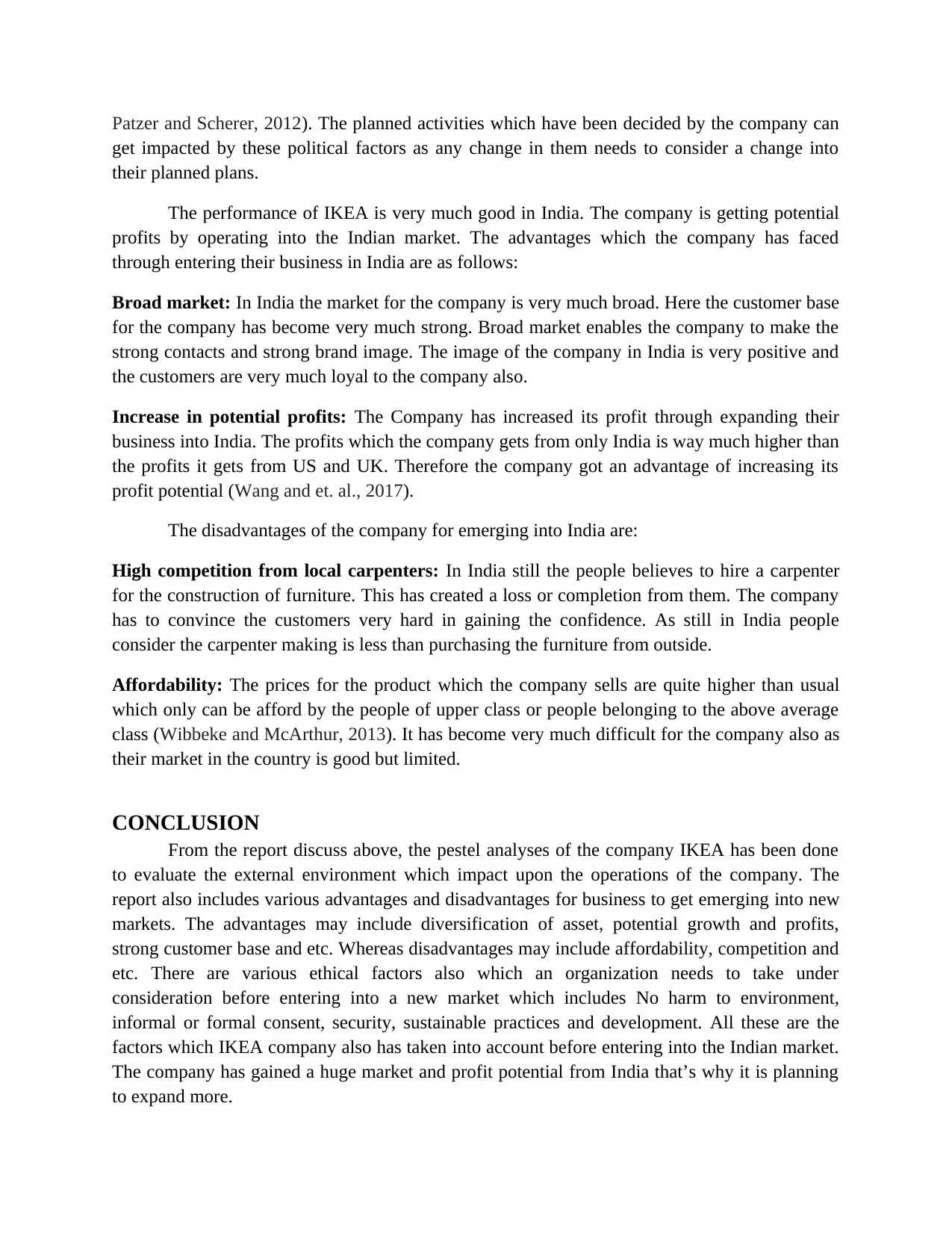
Patzer and Scherer, 2012). The planned activities which have been decided by the company can
get impacted by these political factors as any change in them needs to consider a change into
their planned plans.
The performance of IKEA is very much good in India. The company is getting potential
profits by operating into the Indian market. The advantages which the company has faced
through entering their business in India are as follows:
Broad market: In India the market for the company is very much broad. Here the customer base
for the company has become very much strong. Broad market enables the company to make the
strong contacts and strong brand image. The image of the company in India is very positive and
the customers are very much loyal to the company also.
Increase in potential profits: The Company has increased its profit through expanding their
business into India. The profits which the company gets from only India is way much higher than
the profits it gets from US and UK. Therefore the company got an advantage of increasing its
profit potential (Wang and et. al., 2017).
The disadvantages of the company for emerging into India are:
High competition from local carpenters: In India still the people believes to hire a carpenter
for the construction of furniture. This has created a loss or completion from them. The company
has to convince the customers very hard in gaining the confidence. As still in India people
consider the carpenter making is less than purchasing the furniture from outside.
Affordability: The prices for the product which the company sells are quite higher than usual
which only can be afford by the people of upper class or people belonging to the above average
class (Wibbeke and McArthur, 2013). It has become very much difficult for the company also as
their market in the country is good but limited.
CONCLUSION
From the report discuss above, the pestel analyses of the company IKEA has been done
to evaluate the external environment which impact upon the operations of the company. The
report also includes various advantages and disadvantages for business to get emerging into new
markets. The advantages may include diversification of asset, potential growth and profits,
strong customer base and etc. Whereas disadvantages may include affordability, competition and
etc. There are various ethical factors also which an organization needs to take under
consideration before entering into a new market which includes No harm to environment,
informal or formal consent, security, sustainable practices and development. All these are the
factors which IKEA company also has taken into account before entering into the Indian market.
The company has gained a huge market and profit potential from India that’s why it is planning
to expand more.
get impacted by these political factors as any change in them needs to consider a change into
their planned plans.
The performance of IKEA is very much good in India. The company is getting potential
profits by operating into the Indian market. The advantages which the company has faced
through entering their business in India are as follows:
Broad market: In India the market for the company is very much broad. Here the customer base
for the company has become very much strong. Broad market enables the company to make the
strong contacts and strong brand image. The image of the company in India is very positive and
the customers are very much loyal to the company also.
Increase in potential profits: The Company has increased its profit through expanding their
business into India. The profits which the company gets from only India is way much higher than
the profits it gets from US and UK. Therefore the company got an advantage of increasing its
profit potential (Wang and et. al., 2017).
The disadvantages of the company for emerging into India are:
High competition from local carpenters: In India still the people believes to hire a carpenter
for the construction of furniture. This has created a loss or completion from them. The company
has to convince the customers very hard in gaining the confidence. As still in India people
consider the carpenter making is less than purchasing the furniture from outside.
Affordability: The prices for the product which the company sells are quite higher than usual
which only can be afford by the people of upper class or people belonging to the above average
class (Wibbeke and McArthur, 2013). It has become very much difficult for the company also as
their market in the country is good but limited.
CONCLUSION
From the report discuss above, the pestel analyses of the company IKEA has been done
to evaluate the external environment which impact upon the operations of the company. The
report also includes various advantages and disadvantages for business to get emerging into new
markets. The advantages may include diversification of asset, potential growth and profits,
strong customer base and etc. Whereas disadvantages may include affordability, competition and
etc. There are various ethical factors also which an organization needs to take under
consideration before entering into a new market which includes No harm to environment,
informal or formal consent, security, sustainable practices and development. All these are the
factors which IKEA company also has taken into account before entering into the Indian market.
The company has gained a huge market and profit potential from India that’s why it is planning
to expand more.
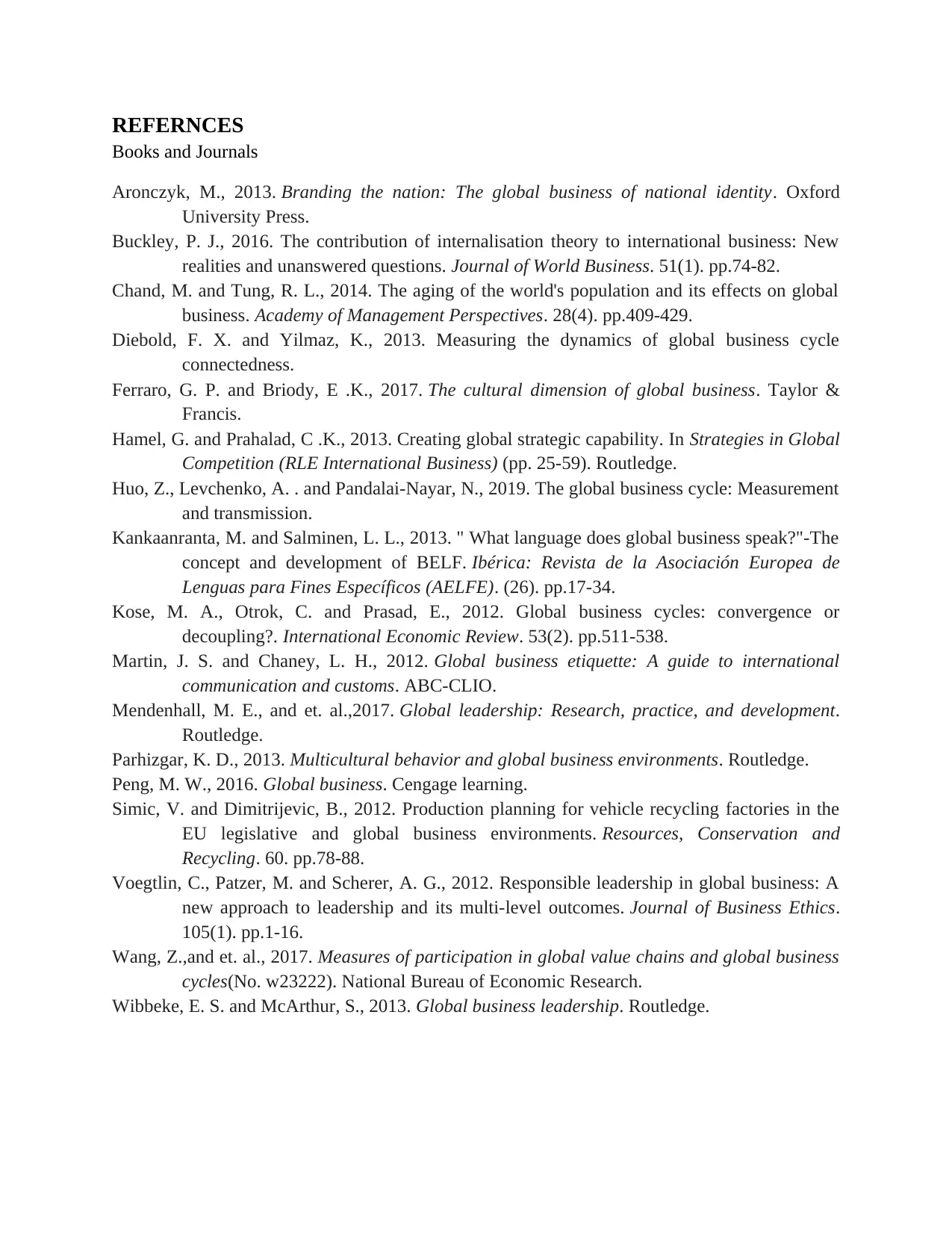
REFERNCES
Books and Journals
Aronczyk, M., 2013. Branding the nation: The global business of national identity. Oxford
University Press.
Buckley, P. J., 2016. The contribution of internalisation theory to international business: New
realities and unanswered questions. Journal of World Business. 51(1). pp.74-82.
Chand, M. and Tung, R. L., 2014. The aging of the world's population and its effects on global
business. Academy of Management Perspectives. 28(4). pp.409-429.
Diebold, F. X. and Yilmaz, K., 2013. Measuring the dynamics of global business cycle
connectedness.
Ferraro, G. P. and Briody, E .K., 2017. The cultural dimension of global business. Taylor &
Francis.
Hamel, G. and Prahalad, C .K., 2013. Creating global strategic capability. In Strategies in Global
Competition (RLE International Business) (pp. 25-59). Routledge.
Huo, Z., Levchenko, A. . and Pandalai-Nayar, N., 2019. The global business cycle: Measurement
and transmission.
Kankaanranta, M. and Salminen, L. L., 2013. " What language does global business speak?"-The
concept and development of BELF. Ibérica: Revista de la Asociación Europea de
Lenguas para Fines Específicos (AELFE). (26). pp.17-34.
Kose, M. A., Otrok, C. and Prasad, E., 2012. Global business cycles: convergence or
decoupling?. International Economic Review. 53(2). pp.511-538.
Martin, J. S. and Chaney, L. H., 2012. Global business etiquette: A guide to international
communication and customs. ABC-CLIO.
Mendenhall, M. E., and et. al.,2017. Global leadership: Research, practice, and development.
Routledge.
Parhizgar, K. D., 2013. Multicultural behavior and global business environments. Routledge.
Peng, M. W., 2016. Global business. Cengage learning.
Simic, V. and Dimitrijevic, B., 2012. Production planning for vehicle recycling factories in the
EU legislative and global business environments. Resources, Conservation and
Recycling. 60. pp.78-88.
Voegtlin, C., Patzer, M. and Scherer, A. G., 2012. Responsible leadership in global business: A
new approach to leadership and its multi-level outcomes. Journal of Business Ethics.
105(1). pp.1-16.
Wang, Z.,and et. al., 2017. Measures of participation in global value chains and global business
cycles(No. w23222). National Bureau of Economic Research.
Wibbeke, E. S. and McArthur, S., 2013. Global business leadership. Routledge.
Books and Journals
Aronczyk, M., 2013. Branding the nation: The global business of national identity. Oxford
University Press.
Buckley, P. J., 2016. The contribution of internalisation theory to international business: New
realities and unanswered questions. Journal of World Business. 51(1). pp.74-82.
Chand, M. and Tung, R. L., 2014. The aging of the world's population and its effects on global
business. Academy of Management Perspectives. 28(4). pp.409-429.
Diebold, F. X. and Yilmaz, K., 2013. Measuring the dynamics of global business cycle
connectedness.
Ferraro, G. P. and Briody, E .K., 2017. The cultural dimension of global business. Taylor &
Francis.
Hamel, G. and Prahalad, C .K., 2013. Creating global strategic capability. In Strategies in Global
Competition (RLE International Business) (pp. 25-59). Routledge.
Huo, Z., Levchenko, A. . and Pandalai-Nayar, N., 2019. The global business cycle: Measurement
and transmission.
Kankaanranta, M. and Salminen, L. L., 2013. " What language does global business speak?"-The
concept and development of BELF. Ibérica: Revista de la Asociación Europea de
Lenguas para Fines Específicos (AELFE). (26). pp.17-34.
Kose, M. A., Otrok, C. and Prasad, E., 2012. Global business cycles: convergence or
decoupling?. International Economic Review. 53(2). pp.511-538.
Martin, J. S. and Chaney, L. H., 2012. Global business etiquette: A guide to international
communication and customs. ABC-CLIO.
Mendenhall, M. E., and et. al.,2017. Global leadership: Research, practice, and development.
Routledge.
Parhizgar, K. D., 2013. Multicultural behavior and global business environments. Routledge.
Peng, M. W., 2016. Global business. Cengage learning.
Simic, V. and Dimitrijevic, B., 2012. Production planning for vehicle recycling factories in the
EU legislative and global business environments. Resources, Conservation and
Recycling. 60. pp.78-88.
Voegtlin, C., Patzer, M. and Scherer, A. G., 2012. Responsible leadership in global business: A
new approach to leadership and its multi-level outcomes. Journal of Business Ethics.
105(1). pp.1-16.
Wang, Z.,and et. al., 2017. Measures of participation in global value chains and global business
cycles(No. w23222). National Bureau of Economic Research.
Wibbeke, E. S. and McArthur, S., 2013. Global business leadership. Routledge.
Secure Best Marks with AI Grader
Need help grading? Try our AI Grader for instant feedback on your assignments.

1 out of 11
Related Documents
Your All-in-One AI-Powered Toolkit for Academic Success.
+13062052269
info@desklib.com
Available 24*7 on WhatsApp / Email
![[object Object]](/_next/static/media/star-bottom.7253800d.svg)
Unlock your academic potential
© 2024 | Zucol Services PVT LTD | All rights reserved.





